Festivals form the special thread for Nepal’s social fabric where customs and cultures closely weave into day-to-day life. Nepalese gather annually to celebrate a wide variety of festivals, each with its own distinctive customs, rituals, and importance. These festivals provide a window into the nation’s rich cultural past. The festivals also showcase everything from vivacious processions and colorful dances to solemn ceremonies and spiritual sacrifices. People across the nation celebrate some of these holidays, while particular areas or towns have their own specific holidays. We shall uncover some of the most unique festivals that you can be a part of, in Nepal.
This blog explores their histories and customs, and illuminates ways of their observation, in the tentative order of occurrences.
Holi

Holi is another popular festival celebrated in Nepal. It usually falls in February or March and is also known as the festival of colors. During Holi, people smear each other with colorful powder and water, and enjoy feasting and dancing. The festival symbolizes the victory of good over evil and the arrival of spring.
All the major ethnic groups in Nepal take part in the vast festivities of the auspicious event of colors. Holi, festival which celebrates love, color, and joy, has recently spread to many areas in North America and Europe.
Shivaratri
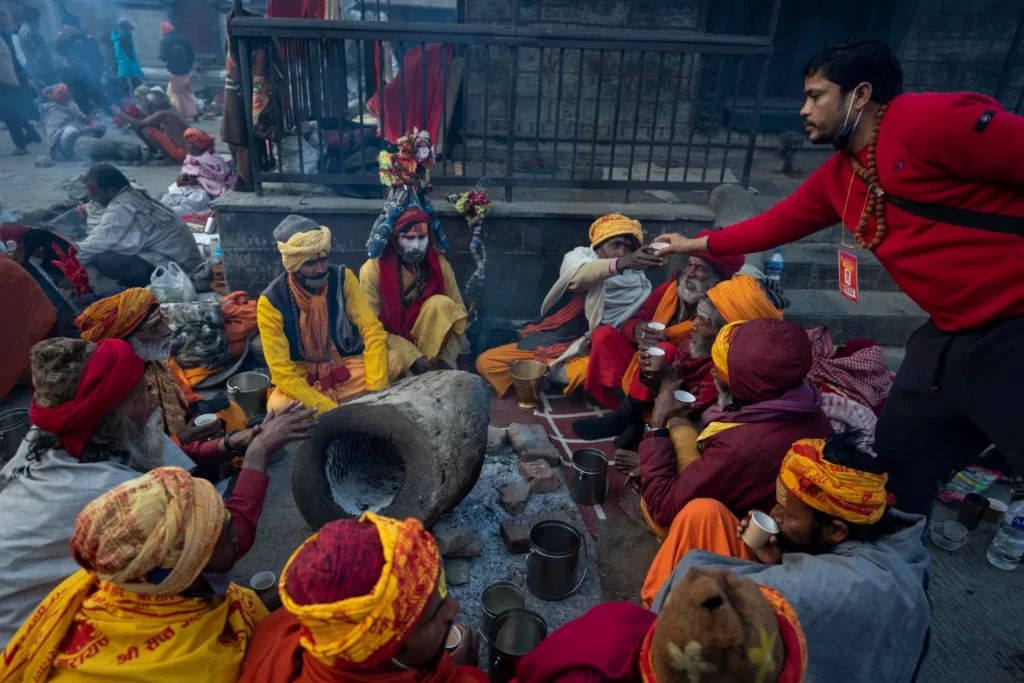
Shivaratri of more specifically ‘Mahashivaratri’ is the most important religious festival for devotees of the Hindu god Shiva. The word Shivaratri literally translates to ‘Great Night of Shiva’. While every lunar month’s 14th day of the dark half is dedicated to Shiva, the months of Magha (January-February) and Falgun (February-March) are particularly special. People believe that nature pushes a person’s spiritual peak towards them on this day, leading to a specific all-night celebration.
Devotees seeking spiritual enlightenment consider Mahashivaratri a crucial day. General people celebrate it as the anniversary of Shiva and Parvati’s wedding. People who have materialistic aspirations regard the day when Shiva defeated all his enemies. The festival represents triumph, sincerity, and forgiveness and is observed throughout Nepal. Devotees of Shiva commit to visiting some of the country’s most important shrines at least once in their lifetime.
Thousands of worshippers flock to Shiva temples on this auspicious day from all over the world. More than a million people go to the Pashupatinath shrine in Kathmandu on the eve of Shivaratri. Pashupatinath is the biggest shrine in the world devoted to Lord Shiva,
Bisket Jatra

Bisket Jatra is a popular Newari festival celebrated annually in the ancient city of Bhaktapur, Nepal. The festival marks two significant events: the end of the Nepali month of Chaitra and the beginning of the new Nepali year in Baisakh (mid-April). According to legend, the festival commemorates the victory of Bhairav over another deity, Bhadrakali. It also revels Bhairav being given the rightful honor of being the city’s guardian deity.
During the festival, a giant chariot carrying the statue of the god Bhairav is pulled by hundreds of local villagers. Huge crowd of poeple, with a group of local musicians accompany the chariot pulling. The chariot rests at certain honored places, where people offer rice, coins, flowers and Sindur to the statue. The festival lasts for 8 nights and 9 days, and locals call it the Chyacha Gunhuya Jatra or Biska Jatra . It is one of Bhaktapur’s most popular festivals, with cultural and historical significance.
This festival is deeply rooted in the country’s rich cultural heritage and history, and it is a testament to the country’s resilience and spirit. Tourists may attend this festival to experience the unique blend of religious fervor and cultural traditions of Nepal.
Tiji Festival
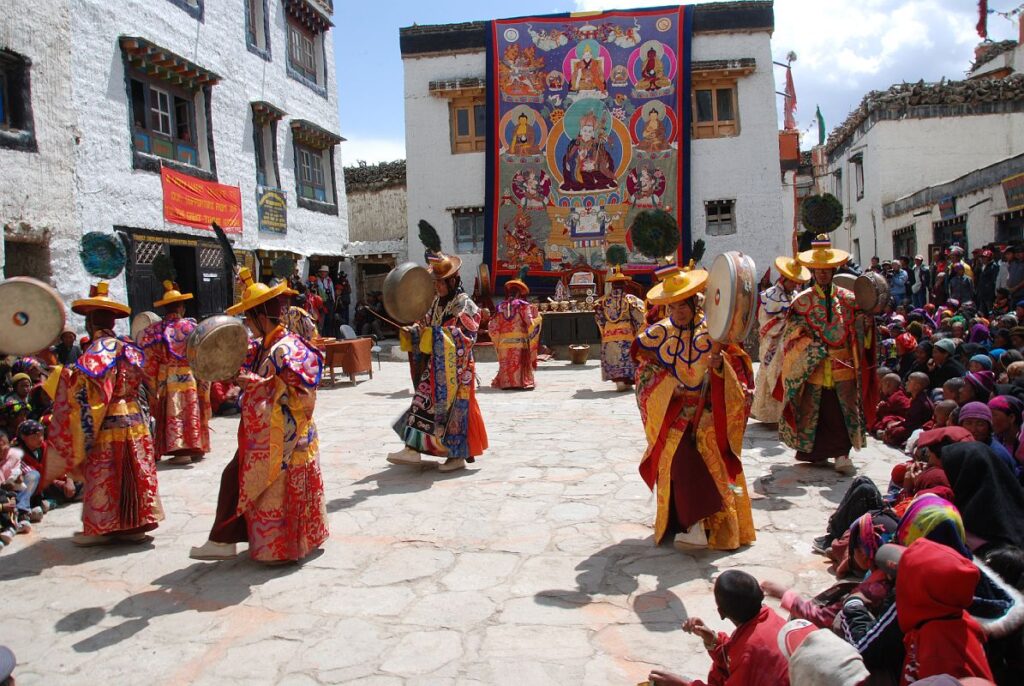
Tiji Festival is an annual celebration that takes place in Upper Mustang, Nepal, attracting tourists from around the world. The festival lasts for three days, tentatively during the month of May. The festival marks the myth of a son who saves the Mustang kingdom from destruction. Monks in elaborate costumes and masks perform rituals to drive away evil spirits. The Tiji Festival is a fascinating display of Tibetan rituals that celebrate the triumph of good over evil, and visitors can witness the monks enacting the defeat of the demon ‘Ma Tam Ru Ta’ through dance performances.
The Tiji Festival is a unique event that showcases the cultural heritage of Nepal, and the isolated region of Upper Mustang offers breathtaking scenery. At an altitude of 3840 meters above sea level, the festival provides visitors with an opportunity to experience the traditional customs and rituals of the local people. The festival is organized by the Choedhe Monastery which belongs to the Sakya sect of Buddhism and is headed by a Rimpoche. During the three-day festival, visitors can witness the Tsa Chaam, NgaCham, and Rha Chham dance performances which are all performed by the local monks. The Tiji Festival is a must-see event for anyone with interest in cultural festivals and the traditional customs of Nepal.
Rato Machhindranath Jatra
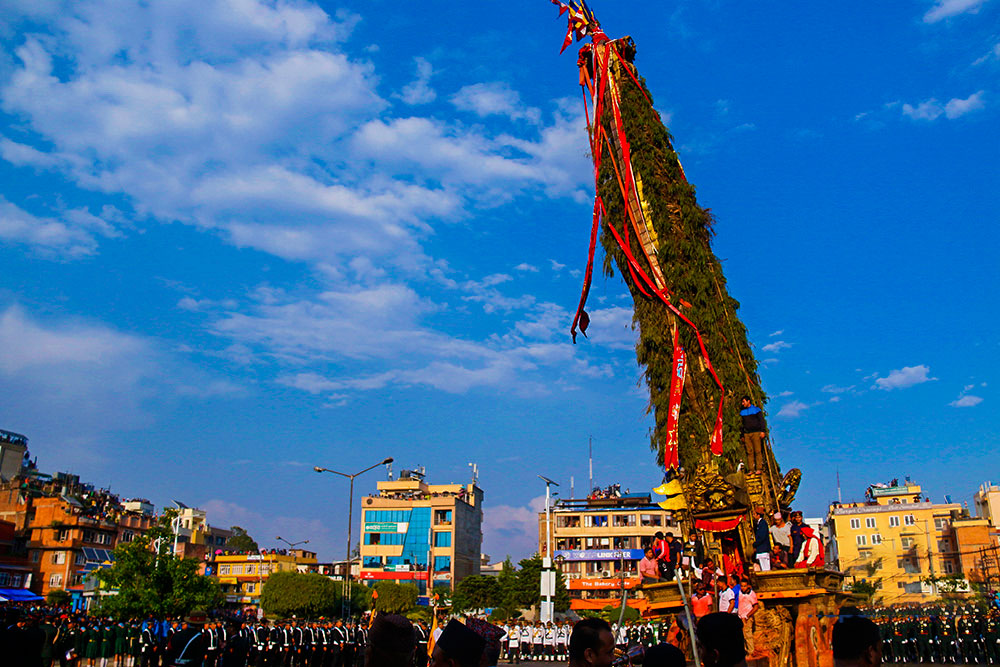
Rato Machhindranath Jatra is the longest-running chariot festival in Nepal, dedicated to the valley’s rain god celebrated annually in May-June. The festival involves a specially-made bamboo and wood chariot carrying the idol of the god, which is hauled by devotees to different localities in Patan. The festival ends with Bhoto Jatra, where they display the rain god’s bejeweled vest. Rato Machhindranath is believed to have been brought from Assam to bless the Kathmandu valley with rain during a prolonged drought, making him the valley’s rain god. The festival has many legends associated with it, all with the same story of seeking the help of Rato Machhindranath to end the drought.
The colorful procession, lively music, and the sight of devotees pulling the massive chariot are a true feast for the senses. The Rato Machhindranath Jatra is an important cultural event in Nepal and attracts thousands of people from all over the country. It is a unique opportunity for visitors to witness the vibrant Nepalese culture and participate in the festivities.
Janai Poornima
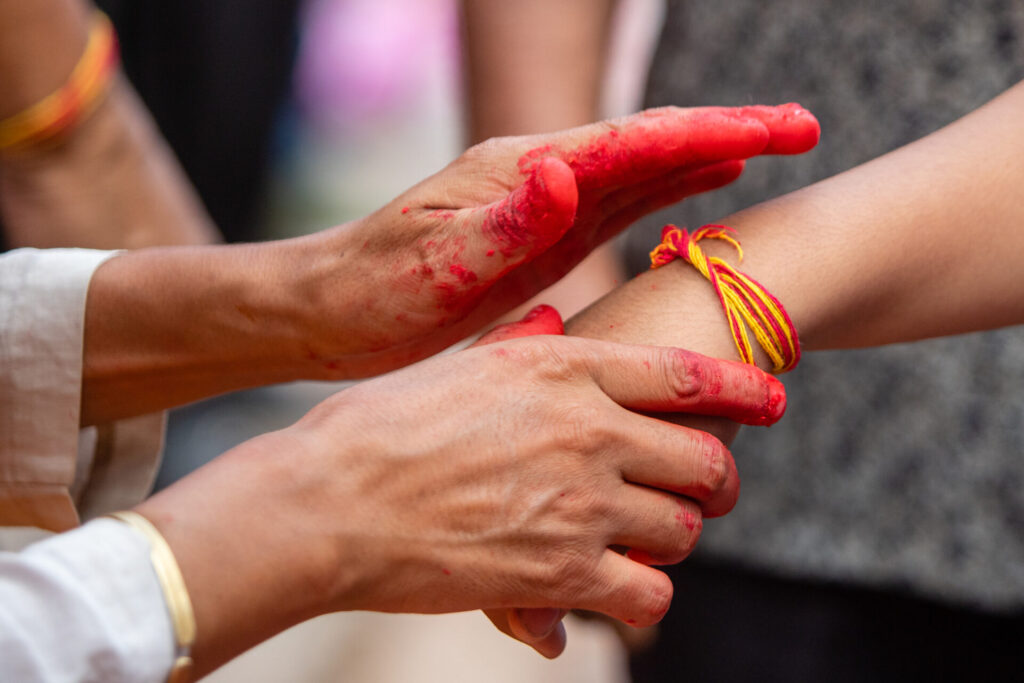
Janai Purnima, is one of the significant festivals observed in Nepal. In Nepal, the Shrawan month, which is between July and August, is typically celebrated on the day of the full moon. Hindu males, particularly Brahmins and Chettris, replace their janai, a sacred thread worn across the torso on this day. The thread is thought to cleanse their souls and guard them against bad energies. Doro − an energized, sacred thread is also tied around the wrist by Hindus during the festival as a sign of protection.
During Janai Purnima, many Nepalese devotees embark on a pilgrimage to holy places, particularly to lakes like Gosaikunda, Panch Pokhari, Badimalika, and Khaptad. These lakes are considered sacred and are believed to have healing energies. Festivals and rituals are also held in these holy places during Janai Purnima.
For tourists visiting Nepal during Janai Purnima, this is a unique opportunity to witness the religious fervor and cultural significance of this festival. They can witness the pilgrimage of devotees, take part in the rituals and celebrations, and experience the beauty and serenity of the holy lakes. It is an excellent way to immerse oneself in the rich cultural heritage of Nepal and gain a deeper understanding of the country’s spiritual traditions.
Teej
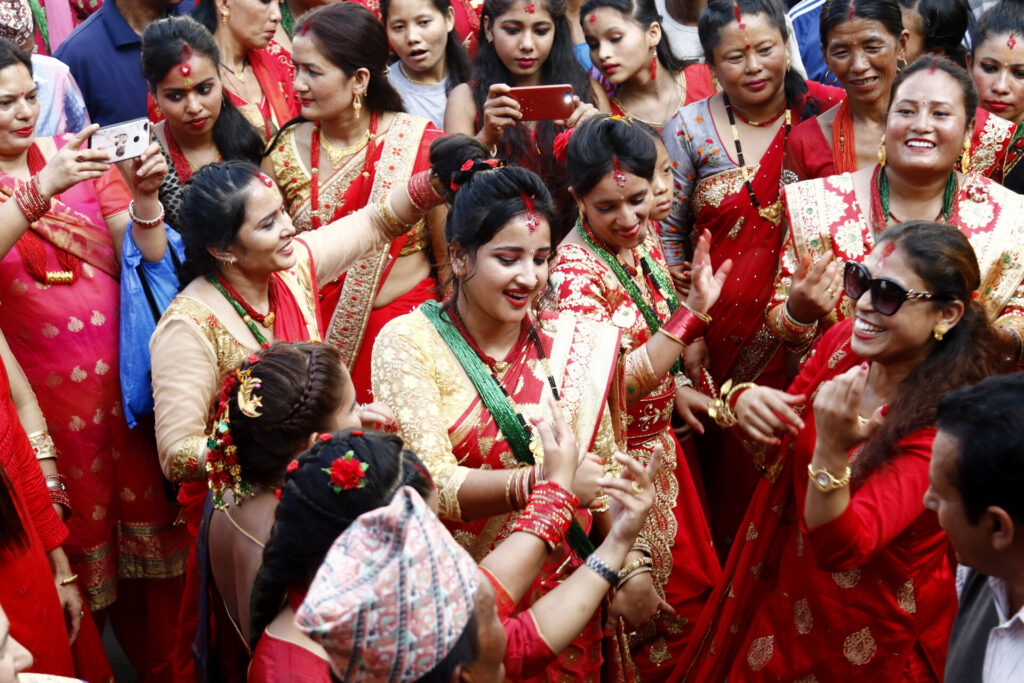
Teej is a significant festival in Nepal, particularly for Hindu women, celebrated to worship Goddess Parvati and commemorate her reunion with Lord Shiva. The festival falls in September and is celebrated for three days, where women fast for a day without consuming any food or water, dress up in traditional attire, and visit nearby temples to offer prayers for the well-being of their family and the long life of their husband. They also gather in groups, sing traditional folk songs, dance to the beats of Nepali drums (madal), apply henna, and exchange gifts and sweets.
Teej is unique to Nepal because of its cultural and religious significance, deeply ingrained in the hearts of the people. It represents the devotion and love of the people towards their traditions and customs, and visitors to Nepal during the festival may witness a vibrant and colorful celebration. It is an excellent opportunity for tourists to experience the rich cultural heritage of Nepal and witness a different way of expressing love between a husband and wife, and between family members.
Indra Jatra

One of the largest and most significant festivals, particularly in the capital city of Kathmandu is Indra Jatra. It is particularly enjoyed by the Newari community in the Kathmandu Valley of Nepal. This festival lasts for eight days and is usually falls in the month of September. Devotees honor Lord Indra, the Hindu god of rain. According to legend, honoring Indra brings abundant harvests and wealth to the people. The festival’s centerpiece is the chariot parade through Kathmandu’s streets of Kumari, the Living Goddess of Nepal. A sizable audience of devotees follow the chariot as it is accompanied by traditional musical bands, dancers, and other artists. The festival also includes masked dances, shows, and several other religious and cultural activities.
Visitors to Nepal at this time can experience the vibrant festival atmosphere as well as the rich cultural history of the Kathmandu Valley. It offers a wonderful chance to experience and learn about the customs and rituals of the Newari community, as well as to see and take part in traditional dances, music, and rituals.
Dashain
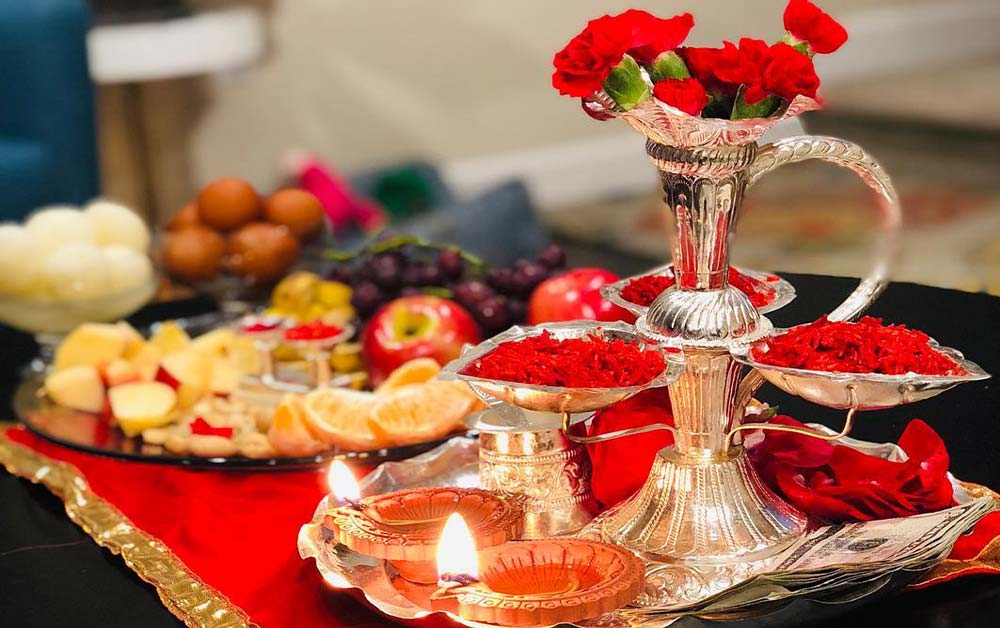
Dashain is one of the biggest and most important festivals in Nepal, celebrated by Hindus and non-Hindus alike. The festival is observed for fifteen days, with the main celebrations taking place during the last five days. It is a time to celebrate the victory of good over evil and to honor the Hindu goddess Durga. During the festival, Nepalese come together to clean and decorate their homes, purchase new clothes and accessories, and prepare delicious feasts. The main rituals involve the offering of tika (a mixture of rice, yogurt, and vermilion powder) and jamara (a sprout of barley) to one another as a symbol of blessing and prosperity. Families also gather to fly kites, play games, and participate in various cultural activities. Dashain is not only a time for religious observance but also a time for social bonding and strengthening of family ties.
Tihar

The festival of lights, Deepawali or Tihar, is one of the most commonly observed holidays in Nepal. Five days of the celebration are dedicated to celebrating different gods, creatures, and connections. The first day is devoted to crows since they are thought to be the messengers of Yama−the god of death. On this day, Nepalese offer food to the crows, acknowledging the crucial role it plays as scavengers in the eco-system and to ward off bad fortune. Dogs, who are thought to be the stewards of Yama’s world, are honored on the second day. To express their appreciation for their loyalty and protection, Nepalese present dogs with garlands made of flowers, tika and delicacies.
The third day, called Gai Tihar, is devoted to cows, which are revered in Hinduism as sacred animals. Cows are honored by having garlands placed on them and having tika painted on their foreheads. Laxmi, the goddess of wealth takes the center stage on the fourth day. People pray and burn lights to bring luck into their homes. The last day, or Bhai Tika, honors the relationship between brothers and sisters. Sisters execute a rite in which they wish their brothers good health and success while exchanging gifts.
Mani Rimdu

Mani Rimdu is a colorful and meditative festival of Sherpa people. The Sherpa people of Nepal’s Khumbu region celebrate Mani Rimdu during the full moon of October or November. The festival is observed for a total of nineteen days, with the main public celebrations taking place over three days. Lamas and Sherpas gather during the festival in the Tengboche Monastery, Thame, and Chiwong. They offer prayers for peace throughout the world and to commemorate the establishment of Buddhism in the region. Each ritualistic dance that the monks conduct symbolizes the victory of good (dharma) over evil (adharma). They perform these exquisite dances while wearing elaborate costumes and masks. During the festival’s final day, hundreds of residents and tourists throng to view the magnificent performances.
Yomari Punhi
Yomari Punhi is a Newari festival celebrated in Nepal during the full moon day of December. This festival is dedicated to the Newari god of wealth and is celebrated with the preparation and consumption of Yomari. Yomari is a sweet delicacy of rice flour dough filled with molasses or sesame seeds. The festival also marks the end of the rice harvest season and the beginning of the winter season. Yomari Punhi is a time of family gathering and community celebration. People of all ages come together to make and enjoy Yomari and other traditional Newari dishes. The festival is also an opportunity for families to give thanks for the harvest and seek blessings for good fortune.
Yomari Punhi is a unique and important cultural festival in Nepal, showcasing the rich traditions and cuisine of the Newari community. Visitors to Nepal during this time can experience the festive atmosphere and sample the delicious Yomari delicacy. The festival can also be the window to learn more about the culture and customs of the Newari people.
